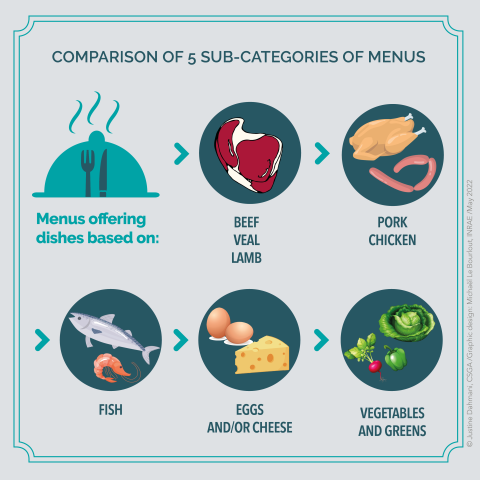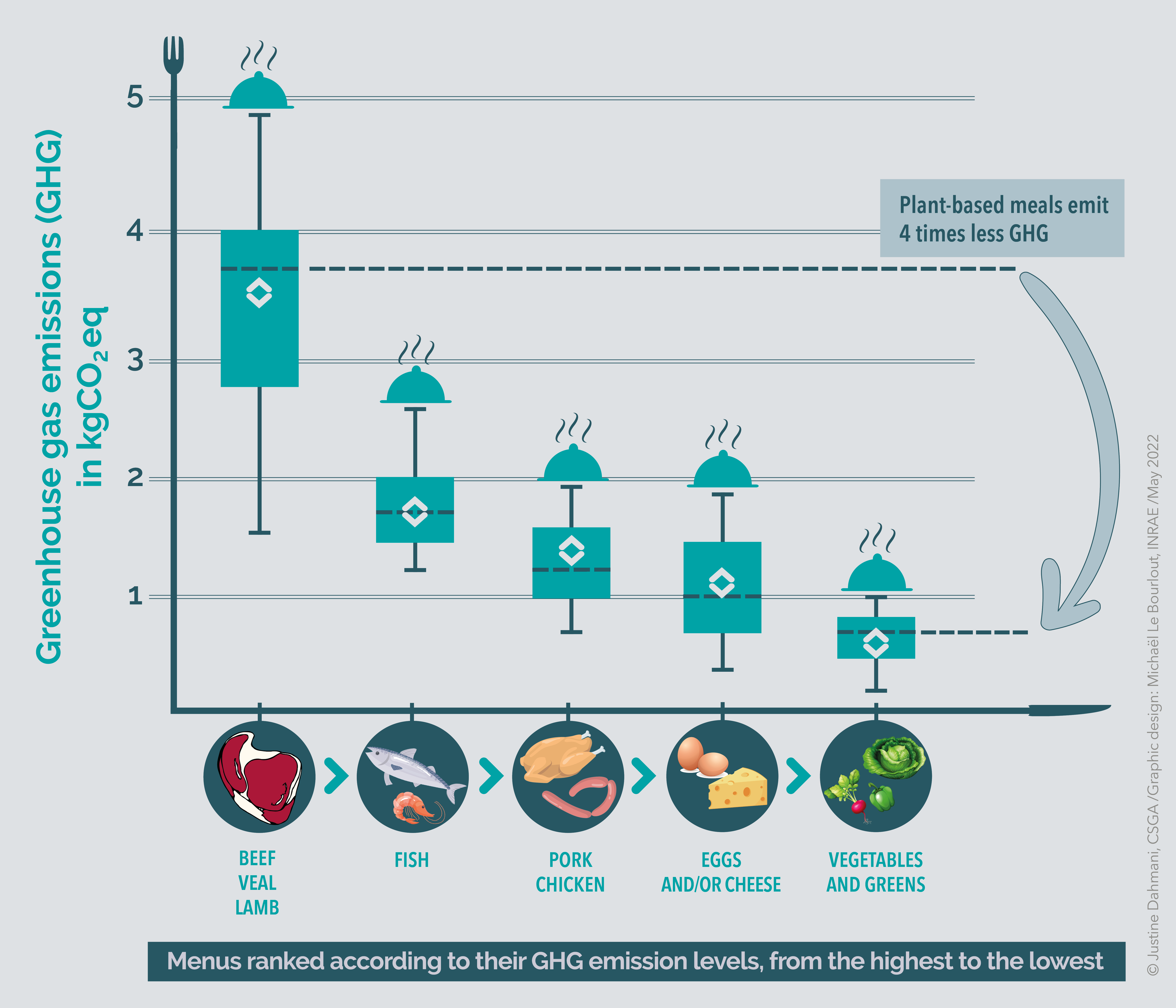Web report
Society and regional strategiesSuper school canteens, supported by the Territoire d’innovation programme
Published on 18 November 2022
The Super School Canteen programme explores the pleasures of eating and trying new foods with the aim of guiding children to eat food that is healthy for both them and the planet. Led by the city of Dijon, the programme implements action to help children enjoy healthy and sustainable meals based on assessments of the sustainability of food used in school catering facilities [see video report below]. It receives funding from Dijon Alimentation Durable 2030, a Territoire d’innovation programme, and is supported by the scientific expertise of Sophie Nicklaus, INRAE Research Director at the Centre for Taste and Eating Behaviour (CSGA) at INRAE’s Burgundy-Franche-Comté centre in Dijon.
“What did you have for lunch? Did you like it?” are two questions asked often at the school gate by parents concerned about their child’s diet. Every week, around 8.5 million children between the ages of 3–17 eat lunch at school canteens across France (Metropolitan France, ANSES 2021 data). Nutritional behaviour specialist Sophie Nicklaus firmly believes that the school canteen is a testing ground and good place to begin educating children on the pleasures of eating a healthy and sustainable diet, and that enjoying healthy food is a habit that children too can learn. In the scope of their work on sustainable diets, Sophie and her team, which is specialised in determinants of eating behaviours throughout life and their effects on health, are studying sustainability in collective catering via the Dijon Alimentation Durable 2030 initiative of the Territoire d’innovation programme [see box]. Their work is also supported by the city of Dijon. The INRAE Research Director ensures the scientific coordination of the project. Super School Canteen focuses on food education in school catering facilities. “Outside the home, schools are the best place to address the many dimensions of a sustainable diet, including health (and therefore) nutritional quality, as well as environmental, economic, cultural and historical aspects.”
Outside the home, schools are the best place to address the many dimensions of a sustainable diet, including health (and therefore) nutritional quality, as well as environmental, economic, cultural and historical aspects.
For several years, the city of Dijon has successfully tested the introduction of weekly vegetarian meal options at its school canteens, which serve 8,000 meals a day. Researchers carefully reviewed meals offered at 38 elementary schools, made and served by the city’s central food preparation unit, a key partner in the programme. The team assesses the nutritional quality and carbon footprint of the 250 lunch menus served daily over the course of the school year. Children use feedback terminals to give their opinion of the main course [see video].
Overall good coverage of nutritional needs
How do we know if the nutrient and energy (kcal) needs of children are being met? Nutritional engineer Justine Dahmani explores this subject as part of a thesis co-supervised by Sophie Nicklaus and Lucile Marty, a research fellow at the CSGA.

The research team compared non-vegetarian and vegetarian menus (containing no meat or fish as a starter or main dish).
More detailed results were obtained by then dividing the menus into five sub-categories based on the type of main dish:
- beef, veal, lamb (red meat),
- pork or chicken (white meat),
- fish
- eggs and/or cheese
- vegetables and greens
The resulting figures speak volumes: on average, one third of a child’s energy requirements and almost one half of their daily recommended intake of 23 nutrients are covered by both types of menus and therefore from the mid-day meal alone! This good news is tempered, however, by the meal-by-category analysis, which revealed disparities depending on the composition of the main course. Fish-based menus, for example, contain more vitamin D and DHA than the others, making them essential in the diet of children for their specific nutritional qualities.
Finding protein in a range of sources
There is room to reduce animal-sourced protein in school menus without causing deficiencies, contrary to a commonly held view
Moreover, every menu type provides sufficient amounts of protein: more than 120% of daily recommended intake in the meat and fish options and 95% in the vegetarian option. These figures are clear: there is room to reduce animal-sourced protein in school menus without causing deficiencies, contrary to a commonly held view. Children’s opinions of the dishes and sides (vegetables, starches, legumes) —an average of 1,600 votes per day— are recorded by feedback terminals installed in September 2021 in each of the 38 participating canteens. The final results will be released at the end of the school year and constitute a body of scientific data unique in France. Trends are already visible in the 44 dishes analysed from September to December 2021, with vegetarian dishes slightly more popular than beef ones. While these results need to be consolidated, Lucile Marty believes they provide food for thought in the debate on how often red meat should be on the menu. They also point to the potential of strategies that combine foods on menus to make certain dishes more popular and reduce waste.
The carbon footprint of meat dishes
Meat and fish menus are responsible for more greenhouse gas emissions than vegetarian ones. Meals based on meats from ruminants in particular have an equivalent footprint of 3.5 compared to 0.7 for a vegetarian meal. “This is the least positive environmental impact. But meat plays an important role in a balanced diet, both nutritionally and culturally,” says Justine Dahmani. This data* indicates that alternatives exist for local authorities seeking to diversify protein sources in menu planning: “Why not introduce a second vegetarian meal per week to replace red meat?” adds the PhD student. “This solution would also compensate for the higher cost of better quality, organic or red label meat, or meat purchased locally, in accordance with the objectives of the EGalim law”.

The notion of food sustainability at the heart of this project is not limited to the environmental footprint
The notion of food sustainability at the heart of this project is not limited to the environmental footprint. “Sustainability is also linked to the social and cultural significance of food. Comparisons of data from different restaurants are an important component of research in a regional project,” says Lucile Marty. We can obtain a detailed picture of each canteen and the eating habits of its families by examining the average meal price (which is adjusted to parental income), attendance rates at the canteens (which vary widely) and the number of pork-free meals served. These parameters can be compared to data on children’s acceptance of new vegetables or vegetarian dishes in order to target priority schools in the food education scheme run by the Dijon local authorities.
* To assess the greenhouse gas emissions of each food, the scientists used data from the Agribalyse 3.0 database. This data is calculated using the life-cycle assessment method More information >
- Patricia Leveillé / translated by Emma Morton
-
Sophie Nicklaus
scientific expert
Determinants of eating behavior across the lifespan, relationship with health (CSGA INRAE)
